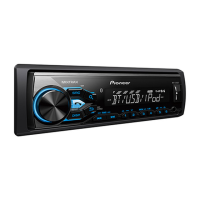
Do you have a question about the Pioneer MVH-X385BT and is the answer not in the manual?
| MP3 playback | Yes |
|---|---|
| CD-R playback | No |
| Audio formats supported | MP3, WAV, WMA |
| DIN size | 1 DIN |
| Output power | 200 W |
| Product color | Black |
| Volume control | Rotary |
| Audio output channels | 4.0 channels |
| Equalizer bands quantity | 5 |
| Maximum power per channel | 50 W |
| Mobile operating systems supported | Android |
| Display type | LCD |
| Display number of lines | 1 lines |
| Supported radio bands | AM, FM |
| Preset stations quantity | 36 |
| USB version | 2.0 |
| Bluetooth profiles | A2DP, AVRCP, HFP, SSP |
| Line outputs (RCA) | 1 |
| Bluetooth functions | Handsfree calling |
| Compatible products | iPhone 4s, iPhone 5, iPhone 5c, iPhone 5s, iPhone 6, iPhone 6 Plus, Android Phones |
General safety warnings, cautions, and advice for safe operation and installation of the unit.
Guidance on what to do if problems occur with the unit, directing users to their dealer.
Overview of basic operations and controls for different models (MVH-X385BT/X185UI, MVH-285BT).
Instructions on how to use the remote control for unit operations.
Details common operations like turning on power, adjusting volume, and selecting sources.
Instructions to cancel the demonstration display mode (DEMO OFF) of the unit.
Steps to reset the unit to its initial settings, restoring factory defaults.
Methods for storing and seeking radio stations, including BSM and manual tuning.
How to search for radio stations based on program type (PTY) information.
Instructions for connecting USB devices, iPods, and AUX input sources.
Details on connecting Android devices using AOA and MTP protocols.
Step-by-step process for connecting Bluetooth devices like phones and audio players.
Adjusting Bluetooth settings such as device list, auto-connect, and PIN code.
Using applications with the unit, including connection methods for iPhone and Android.
Operating applications and controlling playback via the unit's interface.
Adjusting various functions related to radio, sound, and general operation.
Customizing audio output, including fader, balance, equalizer, and loudness.
Configuring system preferences like language, clock, and device connections.
Adjusting display brightness and illumination settings.
Customizing MIXTRAX features like short mode, mix patterns, and display effects.
Important safety warnings and guidelines for connecting the unit's wiring.
Details on connecting the power cord and speaker leads to the unit.
Specific wiring instructions for subwoofers and optional power amplifiers.
Steps for installing the unit into a dashboard using the DIN mounting sleeve.
Solutions for common problems like display issues, intermittent sound, and playback errors.
Meaning and resolution for various error messages displayed by the unit.
Guidelines for using USB storage devices and handling application connection errors.
Details on supported compressed audio file formats like MP3, WMA, WAV, and AAC.
List of compatible iPod models and software versions supported by the unit.
Overview of power ratings, dimensions, audio output levels, and equalizer settings.
Details on the USB standard specification and supported protocols.
Specifications for FM/AM tuners and Bluetooth connectivity, including profiles.